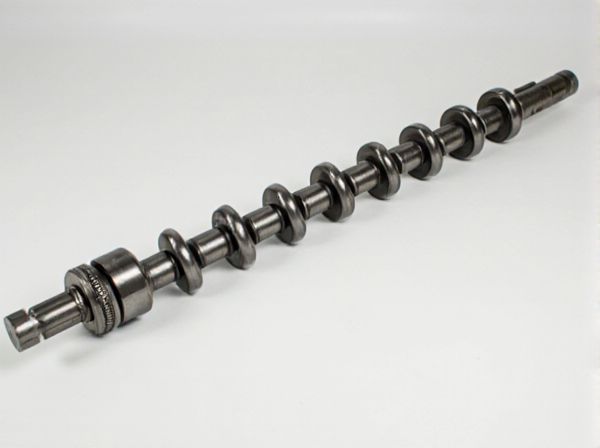
Photo illustration: Eight-counterweight vs Four-counterweight Crankshaft
A crankshaft with eight counterweights offers smoother engine balance and reduced vibration compared to a four-counterweight design, enhancing overall engine performance and longevity. Your engine benefits from less stress on bearings and improved rotational stability with the increased counterweight count. While four-counterweight crankshafts are lighter and simpler, eight-counterweight models provide superior durability and smoother operation in high-performance applications.
Table of Comparison
| Feature | Eight-Counterweight Crankshaft | Four-Counterweight Crankshaft |
|---|---|---|
| Balance | Superior engine balance; reduces vibrations significantly | Moderate balance; higher vibration levels |
| Durability | Enhanced durability due to better stress distribution | Lower durability under high-stress conditions |
| Performance | Optimized for high-performance and smooth operation | Suitable for standard performance and economy engines |
| Weight | Increased weight due to additional counterweights | Lighter construction, less rotational mass |
| Cost | Higher manufacturing cost | Lower production cost |
Introduction to Crankshaft Counterweights
Crankshaft counterweights balance the rotating assembly by offsetting the mass of the connecting rods and pistons, reducing engine vibration and enhancing smooth operation. An eight-counterweight crankshaft offers improved dynamic balance compared to a four-counterweight design, leading to reduced engine stress and longer component life. This optimization is crucial for high-performance and heavy-duty engines where minimizing crankshaft deflection and vibration is essential for reliability and efficiency.
What is a Four-Counterweight Crankshaft?
A four-counterweight crankshaft features four strategically placed counterweights designed to balance engine vibrations and reduce rotational inertia. This configuration improves engine smoothness and durability by minimizing unbalanced forces during the crankshaft's rotation. It is commonly used in smaller engines or lower-performance applications where basic vibration control is sufficient.
What is an Eight-Counterweight Crankshaft?
An eight-counterweight crankshaft features eight strategically placed counterweights designed to balance the rotating assembly more effectively than a four-counterweight crankshaft. This design reduces engine vibrations and enhances smoothness, especially in high-performance or large-displacement engines. The increased number of counterweights also improves bearing life by distributing loads more evenly across the crankshaft journals.
Key Differences: Four vs Eight Counterweights
Eight-counterweight crankshafts provide superior rotational balance by evenly distributing mass, reducing engine vibration, and enhancing overall smoothness compared to four-counterweight crankshafts. Four-counterweight crankshafts are lighter and simpler, making them suitable for smaller engines with lower RPM ranges but may result in increased vibration and less refined engine performance. The choice between four and eight counterweights directly impacts engine durability, noise levels, and vibration control in both high-performance and standard applications.
Performance Impact of Counterweight Design
Eight-counterweight crankshafts offer superior engine balance by effectively reducing vibrations and rotational inertia compared to four-counterweight designs. The increased number of counterweights provides enhanced crankshaft stability, leading to smoother operation and allowing higher RPM limits, which directly improves engine performance and longevity. Improved dynamic balance in eight-counterweight configurations results in reduced bearing wear and better fuel efficiency due to minimized internal friction.
Vibration Reduction and Engine Smoothness
An eight-counterweight crankshaft offers superior vibration reduction compared to a four-counterweight design due to its enhanced mass distribution, which balances the rotating and reciprocating forces more effectively. This improved balance minimizes engine vibrations, resulting in increased smoothness and reduced wear on engine components, especially at higher RPMs. Consequently, engines equipped with eight-counterweight crankshafts deliver a more stable and refined driving experience, promoting longevity and efficiency.
Durability and Engine Longevity
An eight-counterweight crankshaft offers enhanced durability by providing better balance and reducing engine vibrations compared to a four-counterweight crankshaft, which can lead to lower wear on engine components. Improved balance in eight-counterweight designs decreases stress on bearings and crankpins, significantly extending engine longevity, especially in high-performance or heavy-duty applications. Four-counterweight crankshafts are simpler and lighter but may experience increased fatigue and earlier failure under rigorous operating conditions.
Applications and Engine Types
Eight-counterweight crankshafts are predominantly used in high-performance and heavy-duty engines, such as large diesel engines and V8 gasoline engines, to provide superior balance and reduce vibration at higher RPMs. Four-counterweight crankshafts are commonly found in smaller or less powerful engines, including inline-four and V6 configurations, where cost-effectiveness and simpler manufacturing are prioritized over extreme vibration control. The choice between eight and four counterweights directly impacts engine smoothness, durability, and suitability for specific applications like passenger vehicles, trucks, or high-performance racing engines.
Cost and Manufacturing Considerations
An eight-counterweight crankshaft incurs higher manufacturing costs due to increased material usage and more complex machining processes compared to a four-counterweight design. The additional counterweights improve engine balance and vibration control, leading to enhanced durability but require precision casting or forging, which elevates production expenses. Manufacturers must weigh the performance benefits against the increased tooling, labor, and quality control costs inherent in producing eight-counterweight crankshafts.
Choosing the Right Crankshaft for Your Engine
Choosing the right crankshaft depends on engine balance and vibration reduction needs. An eight-counterweight crankshaft offers superior balance, ideal for high-performance or heavy-duty engines requiring smooth operation and durability. Four-counterweight crankshafts, lighter and simpler, suit engines where cost and weight savings are priorities but may result in increased vibrations and reduced longevity.
 caratoz.com
caratoz.com